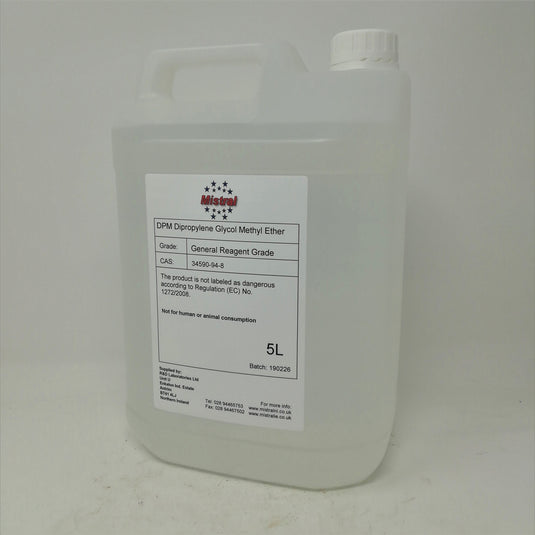DPM
DIPROPYLENE GLYCOL MONOMETHYL ETHER
1-(2-Methoxy-1-methylethoxy)-2-propanol
Technical grade
Cosmetic Grade
DPM / Dipropylene glycol methyl ether is a mid-to slow evaporating solvent. This hydrophilic solvent has 100% water solubility and is ideally suited as a coupling agent in a wide range of solvent systems. DPM glycol ether has a higher flash point than propylene glycol methyl ether (PM) making it easier to handle, store, and ship. More broadly, its hydrophilic nature makes it an ideal coupling aid in water reducible coatings, cosmetic and fragrance, and cleaning applications. DPM glycol ethers intermediate evaporation rate allow it to be used in a potentially wider range of systems than many other solvents.
USES FOR DPM Dipropylene glycol methyl ether
- Coupling agent (often in blends) for water-based dilutable coatings.
- Fragrance carrier for reed diffusers
- Active solvent for solvent-based coatings.
- Coupling agent and solvent in household and industrial cleaners, grease and paint removers, metal cleaners, and hard surface cleaners.
- Tail solvent for solvent-based gravure and flexographic printing inks.
- Primary solvent in solvent-based silk screen printing inks.
- Coupling agent in solvent blends for water-based gravure, flexographic, and silk screen printing inks.
- Coupling agent and solvent for vat dyeing fabrics.
- Stabilizer for agricultural herbicides.
- Coalescent for floor polishes and finishes
1. Solvent in Coatings and Paints
-
Used in water-based paints, varnishes, and lacquers.
-
Improves flow and leveling properties.
-
Slows drying time to allow better film formation.
2. Cleaner and Degreaser Formulations
-
Common in industrial and household cleaners. Often known as a water-based solvent for degreasers
-
Dissolves oils, greases, waxes, and inks effectively.
-
Gentle on surfaces but highly effective.
3. Printing Inks
-
Acts as a solvent that improves drying rate and spreadability.
-
Helps maintain ink stability and prevents clogging in inkjet printers.
4. Personal Care Products
-
Used as a carrier solvent in fragrances, reed diffusers, deodorants, or hair sprays. is used in cosmetics and fragrance products primarily as a solvent, carrier, and viscosity controller. Its low odour, mildness, and compatibility with many ingredients make it useful in select personal care formulations.
-
Provides solubility and mildness without strong odour.
- See Below for more information on DPM in use for cosmetics and fragrance applications
5. Textile and Leather Applications
-
Used in dyeing and finishing processes for its ability to dissolve water-insoluble dyes and improve penetration.
6. Electronics and Semiconductor Cleaning
-
Included in formulations for precision cleaning due to its solvency and low toxicity.
Properties of Dipropylene glycol methyl ether:
- Formula: CH3O[CH2CH(CH3)O]2H
- CAS No: 34590-94-8
- Molar mass: 148.2 g mol-1
- Density: 0.951 g/cm, liquid
- Boiling Point: 190 C
- Viscosity: 3.7 cP at 25 C
- Evaporation Rate (n-butyl acetate=1): 0.035
- Other Names: Methoxy dipropanol, Ucar solvent 2LM, Dowanol DPM, Dowanol-50B, DPGME, PPG-2 methyl ether, Bis(2-(methoxypropyl) ether, Dipropylene glycol monomethyl ether, Dipropylene glycol methyl ether, (2-Methoxymethylethoxy)propanol, HSDB 2511, Propanol, (2-methoxymethylethoxy)-, Dipropylene glycol, monomethyl ether, EINECS 252-104-2, 1-Propanol, 2-(2-methoxypropoxy)-, CID25485, 1-(2-Methoxyisopropoxy)-2-propanol, 1,4-Dimethyl-3,6-dioxa-1-heptanol
PLEASE NOTE: This product is not for human or animal consumption.
Click here to view sales specification sheet
DPM for use in Cosmetics and Fragrance
1. Solvent for Active Ingredients
-
DPM dissolves fragrance oils, essential oils, and functional actives that might not be water-soluble.
-
Helps maintain clarity and stability in solutions (e.g. perfumes, reed diffusers, sprays).
2. Carrier for Fragrance
-
Used in fine fragrance, body mists, reed diffusers and room sprays as a non-greasy diluent.
-
Enhances fragrance longevity and even evaporation, giving smoother top-to-base note transitions.
3. Evaporation Control
-
Slower evaporating than ethanol or isopropanol.
-
Moderates dry-down speed of sprays, reed diffusers and fragrances, preventing overly fast dissipation.
4. Mildness and Compatibility
-
Non-sensitizing and low-irritant at typical use levels.
-
Mixes well with water and alcohols, making it suitable for emulsions, gels, and aerosols.
Examples of Use in Products
| Product Type | DPM Role |
|---|---|
| Eau de toilette / perfume | Solvent and fixative for fragrance oils |
| Deodorant sprays | Carrier solvent, reduces stickiness |
| Hair sprays | Improves distribution, dissolves resins |
| Air fresheners | Solubilizes fragrance in aqueous or alcohol base |
| Moisturizers (rare) | Can aid solubilization of botanical extracts |
Formulation Notes & Restrictions
-
Typical usage level: 0.5–10% depending on the product.
-
May be used as part of a solvent blend with ethanol or other glycols.
-
Should be tested for skin compatibility in final formulation; while generally mild, DPM is not as common as dipropylene glycol (DPG) in leave-on skincare.
DPM vs DPG (Dipropylene Glycol)
-
DPM: A methyl ether derivative, slightly more volatile, with solvent properties suited to fragrance delivery systems.
-
DPG: More common in cosmetics, particularly in fragrance bases and humectants for skin and hair products.
